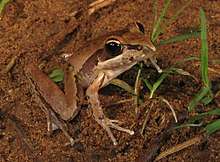Watjulum frog
The Wotjulum frog (Litoria watjulumensis) is a species of frog in the family Pelodryadidae. Its habitats are subtropical or tropical dry forests, subtropical or tropical moist lowland forests, subtropical or tropical swamps, rivers, intermittent rivers, swamps, freshwater lakes, freshwater marshes, intermittent freshwater marshes, and rocky areas.
| Watjulum frog | |
|---|---|
 | |
| Scientific classification | |
| Kingdom: | Animalia |
| Phylum: | Chordata |
| Class: | Amphibia |
| Order: | Anura |
| Family: | Pelodryadidae |
| Genus: | Litoria |
| Species: | L. watjulumensis |
| Binomial name | |
| Litoria watjulumensis (Copland, 1957)[2] | |
 | |
| Synonyms | |
| |
L. watjulumensis was named for Watjulum Mission in the north of Western Australia, a sometimes spelled 'wotjulum'. This has led to variants in the common names and the specific epithet, repeating the spelling of Tyler's publication as Hyla wotjulumensis. The common names include Watjulum or Wotjulum frog, Watjulum Mission tree frog, and giant or large rocket frog.[3]
The publication of the species was based on a type collection by Copland. The collection, 29 specimens at the Western Australian Museum, was reassigned as three syntypes; for this species, Litoria coplandi, and Litoria peronii.[4] The type for Litoria watjulumensis was collected near Watjulum mission "close to Yampi Sound, north of King Sound".[2]
References
- Hero, J.-M., Roberts, D., Horner, P. & Retallick, R. 2004. Litoria watjulumensis. 2006 IUCN Red List of Threatened Species. Downloaded on 21 July 2007.
- Department of the Environment and Water Resources. "Species: Litoria watjulumensis (Copland, 1957) Copland's Rock Frog". Australian faunal Directory. Australian Government.
- Frost, Darrel. "Litoria watjulumensis (Copland, 1957)". Amphibian Species of the World 5.3 (online). The American Museum of Natural History. Retrieved 13 July 2009.
- Tyler, M.J. 1968. A taxonomic study of hylid frogs of the Hyla lesueuri complex occurring in north-western Australia. Records of the South Australian Museum 15: 711–727 [716].
